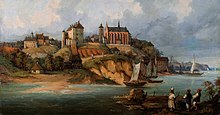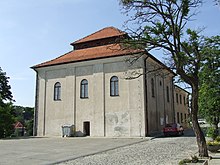Sandomierz
| Sandomierz | ||
|---|---|---|

|
|
|
| Basic data | ||
| State : | Poland | |
| Voivodeship : | Holy Cross | |
| Powiat : | Sandomierz | |
| Area : | 28.80 km² | |
| Geographic location : | 50 ° 41 ′ N , 21 ° 45 ′ E | |
| Residents : | 23,494 (Jun. 30, 2019) |
|
| Postal code : | 27-600 | |
| Telephone code : | (+48) 15 | |
| License plate : | TSA | |
| Economy and Transport | ||
| Next international airport : | Rzeszów-Jasionka | |
| Gmina | ||
| Gminatype: | Borough | |
| Residents: | 23,494 (Jun. 30, 2019) |
|
| Community number ( GUS ): | 2609011 | |
| Administration (as of 2019) | ||
| Mayor : | Marcin Marzec | |
| Address: | pl. Poniatowskiego 3 27-600 Sandomierz |
|
| Website : | www.sandomierz.pl | |
Sandomierz [ sanˈdɔmʲɛʃ ] ( German Sandomir ) is a town on the Vistula in southeastern Poland with around 25,000 inhabitants (as of June 30, 2014). The city is located in the 1999 newly formed Świętokrzyskie (Świętokrzyskie), previously in the province Tarnobrzeg (1975-1998).
history
middle Ages
The city of Sandomierz is one of the most important cities in the Polish section of the Via Regia and was first mentioned in the 10th century. In 1138 it became the center and capital of a Lesser Poland duchy of Sandomir . Sandomierz was therefore frequently visited by Polish kings. The city charter Sandomierz was awarded in 1236th The city was sacked during the Mongol storm in 1241. In 1259, the Tatars took Sandomierz and burned down parts of the city, including St. Mary's Church. In 1286, Duke Leszek the Black ordered the city to be re-founded under Magdeburg law . The Polish King Casimir III. chartered and expanded the rights of the city in 1366, in whose castle he resided several times. The importance of the city at that time is also evident from the fact that King Casimir III. Sandomir included in his ruler title: "King of Poland and Russia, lord and heir of the lands and duchies of Cracow, Sandomir ..." ( Rex Polonie et Russie, nec non Cracovie, Sandomirie ... Terrarum et Ducatuum Dominus et Heres ). Since the 14th century, Sandomir was the capital of the Sandomir Voivodeship .
The current cityscape of the old town essentially goes back to the second half of the 14th century. The old town was then surrounded by a city wall, its extension was about 600 meters in north-south direction and 200 meters in east-west direction. In the city center is the Rynek market square with the town hall. At the southern city gate was the entrance to the port facilities on the Vistula and to the castle of the dukes, which is located outside the city fortifications on the high bank of the Vistula. At the northern city gate (Opatower Tor) is the Heiliggeist-Spital, as an early charitable foundation and nursing home for the elderly and the sick.
The former collegiate church (started around 1360) in the southern old town was elevated to the rank of cathedral in 1818 . Outside the protective city fortifications are the Michaeliskirche with attached Benedictine monastery and the so-called Reformed monastery as well as the Dominican monastery . There was also a Jewish community in Sandomierz early on, the synagogue of which is on the western city wall in Basztowa Street.
Early modern age
The economic basis of the city's population was formed by handicrafts and the grain trade on the Vistula, to which the city owes a cultural boom in the 16th century. Around the market you will find town houses that have well-preserved wine and storage cellars connected by corridors.
In 1570, envoys of the Polish Lutherans , Reformed and Bohemian Brothers in Sandomierz agreed on the Consensus Sandomiriensis , an agreement by which they recognized the legality of their respective denominations and committed themselves to mutual support.
During the Second Northern War , Swedish troops took Sandomierz in 1655. The war put an end to the urban heyday.
After the Swedish King Charles XII. After conquering Warsaw and Krakow in the Great Northern War , the Saxon-Polish King August had to retreat with his troops to Sandomierz in 1702. Representatives of noble Polish families who supported King August came together in the Sandomir Confederation .
19th and 20th centuries

In the Austrian campaign against the Duchy of Warsaw in 1809, Austrian troops moved into Sandomierz, but had to vacate the city on May 18, 1809 after a lost battle against Polish troops led by Stanisław Potocki (1776-1830).
The fourth edition of Meyer's Konversations-Lexikon notes on Sandomir: "District town in the Polish-Russian Radom governorate ... has an old castle on a steep rock, a grammar school, two sugar factories and (1885) 5905 inhabitants."
During the Second Polish Republic , Sandomierz was designated the center of an industrial area to be created. As a result of the Second World War , this project was not realized. During the advance of the Red Army in 1944, the artillery commander Colonel Skopenko, impressed by the picturesque townscape, prevented the city from being bombarded by ignoring the order received. In view of their hopeless situation, the German units that had to defend the city surrendered without a fight, so that the old town survived the war almost undamaged.
Attractions
The old town of Sandomierz is one of the best preserved in Poland. Its urban structure with the large Stary Rynek (old market) is typical of the second half of the 14th century.
Romanesque
- St. Jacob's Church ( Św. Jakub ), 1226, Romanesque, the oldest building entirely made of brick in the Kingdom of Poland, with the Dominican monastery
Gothic
- St. Mary's Cathedral , 1340, with a free-standing bell tower
- Town hall (Gothic 14th century, rebuilt in the 16th century)
- Opatower Gate ( Brama Opatowska ), 14th century
- Church of the Holy Spirit ( Św. Duch ), 14th century
- Długosz House ( Dom Długosza ), named after its founder, now the Diocesan Museum
Renaissance
- Collegium Gostomianum , built by Michał Hintz in 1604–1615, originally a Jesuit college, one of the oldest schools in Poland
- House number 4 on Stary Rynek with a late Renaissance portal
Baroque
- several houses on Stary Rynek:
- House No. 5 Bobola – Konvikt, former dormitory for schoolchildren
- House No. 10 Oleśnicki House, this is where the Sandomierz consensus was concluded
- House No. 12, former main guard house
- House No. 14 House of the composer Mikołaj Gomółka
- House number 23 Kojszor house
- House No. 27 Łazarczyk House "Zum Schnabelschuh"
- The castle, originally a 14th century castle, was rebuilt in the Renaissance style in 1525, but only got its current appearance after it was destroyed by the Swedes in 1655
- The Archangel Michael Church (from the 17th century by Michał Link) with a Benedictine monastery and seminary
- The Josephskirche (1697) with the former Reformate monastery
- The Synagogue of Sandomierz, a brick building built in 1768 in the west of the old town, suffered destruction in the Second World War and today serves as the state archive
- The warehouse, built in 1696 for the Collegiate Church in Sandomierz , originally located at the Vistula harbor
traffic
Sandomierz is still served by a pair of long-distance trains on the Łódź – Dębica line, which continues on a connection to the Sobów – Stalowa Wola line towards Stalowa Wola.
Twin cities
Sandomierz has partnerships with the following cities (the year of establishment in brackets):
- Emmendingen , Germany (1990)
- Ostroh , Ukraine
- Newark on Trent , England
sons and daughters of the town
- Mikołaj Gomółka (* around 1535, † after 1591, probably 1609), musician and composer
- Tomasz Kowalkowski z Kowalikowa h. Przeginia (around 1565, † 1646), royal notary, interim judge of Sandomierz
- Jerzy Ossoliński (1595–1650), statesman
- Ignacy Maciejowski (1835–1901), writer, playwright and literary critic
- Samuel Finkelstein (1890–1942), painter
- Andrzej Schinzel (* 1937), mathematician
- Piotr Nurowski (1945–2010), sports official and victim of the plane crash near Smolensk
- Leszek Cieślik (* 1955), politician
- Jarosław Kowalski (* 1974), snooker player
- Maciej Płaza (* 1976), prose writer, translator and literary critic
- Karol Bielecki (* 1982), handball player
- Karolina Kołeczek (* 1993), athlete
literature
- Thomasz Torbus: Poland . In: DuMont art travel guide . DuMont Reiseverlag, Cologne 2002, ISBN 3-7701-5287-5 , Kleinpolen / Sandomierz, p. 219-220 .
Web links
- City website
- Sandomir . In: Meyers Konversations-Lexikon . 4th edition. Volume 14, Verlag des Bibliographisches Institut, Leipzig / Vienna 1885–1892, p. 272.
- Tourist information in Polish
- sandomierz.org Portal in Polish
Footnotes
- ↑ a b population. Size and Structure by Territorial Division. As of June 30, 2019. Główny Urząd Statystyczny (GUS) (PDF files; 0.99 MiB), accessed December 24, 2019 .
- ^ Gotthold Rhode : History of Poland. An overview . Wissenschaftliche Buchgemeinschaft, Darmstadt, 3rd edition 1980, p. 32.
- ↑ Nikolaus Paulus: Famous, but spurious indulgences . In: Historisches Jahrbuch , vol. 36 (1915), pp. 481–515, here p. 508.
- ↑ Sandomierski skład soli in 1000 lat historii ( 1000 years of history of the city of Sandomierz, Polish), accessed on November 28, 2019.
- ↑ Poznan Literary Society (ed.): Codex diplomaticus Majoris Poloniae documenta, et jam typis descripta, et adhuc inedita complecentens, annum 1400 attingentia . Vol. 3: 1350-1399 , Posen 1879, document no. 1340 (contract with Emperor Charles IV of May 1, 1356).
- ↑ These can still be viewed over a length of 400 meters during city tours.
- ↑ Janusz Małłek: Sandomir, Consensus of . In: Theologische Realenzyklopädie (TRE), Vol. 30: Samuel - Seele . De Gruyter, Berlin 1999, pp. 29-32.
- ↑ Historical view from 1729: Gesta ad Sandomiriam d. 24. Marti 1656. quando Ser. Rex Sueciæ structo ponte navali Vistulam traiecit - - aspicientibus Polonicis et Lithuanicis copijs in tres Exercitus divisis ( digitized version )
- ^ Meyers Konversations-Lexikon , Vol. 14: Rüböl - Sodawasser . Bibliographisches Institut, Leipzig 1888, p. 272.
- ↑ City of Sandomierz ( Memento of the original from September 16, 2015 in the Internet Archive ) Info: The archive link was inserted automatically and has not yet been checked. Please check the original and archive link according to the instructions and then remove this notice. (accessed on Oct. 13, 2015)







